Copyright © 1999 by Lauren Onkey, all rights reserved. This text may be used and shared in accordance with the fair-use provisions of U.S.Copyright law, and it may be archived and redistributed in electronic form, provided that the editors are notified and no fee is charged for access. Archiving, redistribution, or republication of this text on other terms, in any medium, requires the notification of the journal and consent of the author.
- In February of 1998 at the University of South Carolina, Noel Ignatiev, the author of How the Irish Became White (Routledge, 1995) gave the keynote lecture at the Southern Regional meeting of the American Conference for Irish Studies. [For Ignatiev's work in general, see his Race Traitor site: http://www.postfun.com/racetraitor] In his talk, Ignatiev argued that the Irish did not have access to white privilege when they emigrated to America, but "learned" to be white by distancing themselves, often violently, from African Americans. As he argues in the book, "To become white [the Irish] had to learn to subordinate county, religious, or national animosities, not to mention any natural sympathies they may have felt for their fellow creatures, to a new solidarity based on color--a bond which, it must be remembered, was contradicted by their experience in Ireland" (96). The audience was tense and divided after Ignatiev finished speaking. Some people clapped halfheartedly while others gave him a standing ovation. He received a few hostile questions, especially about the issue of whether or not Irish immigrants could have acted any differently towards blacks. At the lecture, he emphasized that the Irish had a choice; they could have made alliances with African Americans rather than embracing whiteness. In the book, Ignatiev makes this point emphatically:
After the Civil War, Southern recalcitrance pushed the Republican Party to embrace Negro suffrage in the South (although many Republicans continued to oppose it in the North). That bold step opened the door to a far-ranging social revolution, the establishment of a degree of proletarian political power in the governments of Southern states under reconstruction. For a brief moment the abolitionists-men like Wendel Phillips, and women like Sojourner Truth and Lydia Maria Child-stood at the head of a nation struggling to find its soul. In this struggle the Irish threw their weight on the scales, and not, it may be said, on the side of the angels (165). (emphasis mine)
- The choice issue is the crux of the debate over Ignatiev's thesis; were the Irish forced by social and economic conditions to pit themselves against African Americans, or could they have taken another path? This is a very difficult question, and Ignatiev's emphatic answer is perhaps too simplistic, as many reviewers have suggested. [1] But many people in the audience in South Carolina interpreted Ignatiev's thesis as an attack on the Irish as a people. Historian Janet Nolan had a similar response in her review of the book:
Ignatiev's thesis belongs to the body of work that seeks to explain the Irish experience in America as a pathology. Ignatiev sees the Irish as free agents in an arena not of their own creating. In the end, this reader was prompted to ask, are the Irish to be blamed for singlehandedly creating white supremacy in the United States? Ignatiev's book seems to suggest that this is so. (487)
Ignatiev's book has its problems, but it is an important contribution to our understanding of the meaning of Irish-black relations. In the nineteenth century, these relations veered from riots and lynching to intermarriage, shared labor, and shared leisure. The book is more of an indictment of a capitalist system which pits two groups of workers against each other than an attack on the Irish. What is it about the meaning of Irish-black relations that causes such tension in Irish studies and the Irish-American community?
- Irish-black relations affect the meaning of the Irish in America because they reveal the discrimination Irish Americans faced upon arrival -- some would argue because of their ambiguous racial status -- and, most importantly, the politics of their "oppressed" status in contemporary America. Arguments like Ignatiev's complicate the definition of Irish Americans as an oppressed people, a definition that has enabled certain appealing but simplistic historical narratives. Many people have an interest in defining the Irish as an oppressed group. Both conservative "Hibernophiles," who want to celebrate Irishness and who in some ways cherish the definition of the Irish Americans as oppressed, and nationalists, who value and romanticize Irish-black connections because of what such connections suggest about Northern Ireland, can be hostile to the argument that the Irish contributed to anyone else's oppression in America. An "oppression" narrative which does not engage problematic Irish-black relations works to suppress discussion of events like the 1975 Boston busing riots or the race riot in Chicago in 1919, or the New York City Draft Riots of 1863.
- For example, an early segment of the 1998 PBS - Disney documentary The Irish in America opened with the conflicts between African Americans and famine immigrants in New Orleans. Historian Lawrence McCaffrey states, "Slave owners, for example, respected black laborers much more than they did Irish laborers. . . . So you put the Irish into . . . working situations where you wouldn't want to risk black slaves." Terence Folan added, "Slaves were an investment by a slave owner . . . if a slave was killed on a dangerous job, the entire investment was lost. If an Irishman was killed, you just got another one." While their comments certainly overstated the case of the "value" of slaves, the placement of this story at the beginning of the narrative of the arrival of the famine Irish was promising; it suggested that the creators of the project understood the importance of race relations to the history of the diaspora. Peter Quinn posed the crucial question which framed their relations: "Who's going to get up the ladder, because there's not room for both of us?" Frank McCourt, no diaspora historian but America's latest most popular Irishman, then appears to describe the attacks Irish gangs undertook on blacks on the docks: "The Irish had to have those jobs. There was no other way for them to survive. . . . If they didn't get the job, they would starve and their families would starve." The narrator acknowledges the injustice of the situation, but concludes with a sense of Irish victory--grim and hard-won, certainly, but a victory nonetheless: "when the blacks fought back, nobody else stood with them. The Irish were white men, after all, and free to do what they had to do. . . . there was a sense that New Orleans was a place where the famine Irish could make it. That New Orleans, after all, might just be a lucky town."
- After this segment, there is no further discussion in the series of what the narrator had called "one of the longest-running racial grudge wars in the country." The draft riots are not named as such; they are covered using a single illustration and the following voice over: "The full Irish war record was a complicated one. Incensed by laws that permitted the rich to buy their way out of the fight, Irishmen staged the bloodiest riots in the country." The Irish in America makes a compelling case for the intense discrimination the Irish faced in America, but it simplifies and distorts the meaning of race in the process. [2]
- Any project which engages the politics of race in the diaspora has to simultaneously recognize discrimination that Irish immigrants faced and also the ways that they participated in the denigration of African Americans. The "truth" of the relationship oscillates between identification and loathing; genuine solidarity is quite rare. In her excellent analysis of "Hibernophile" interest in the black-Irish connection, Catherine Eagan argues:
While Irish-Americans are quick to claim an understanding of 'oppression' in common with African-Americans, they often deny the great impact of racial difference on the African-American experience, and claim that black Americans should be able to pull themselves up by their own bootstraps just as the Irish did . . . . Instead of admitting how their embrace of what W.E.B. DuBois called the 'wages of whiteness' helped them get ahead, Irish-Americans often join with the mainstream in believing that race doesn't matter and that doors will eventually be opened to descendants of African slaves in the same way that they were opened to the children and grandchildren of Irish immigrants. This view, of course, does not threaten to disrupt Irish-Americans' romanticization of the cultural and historical connections between Irish and African peoples. (6)
If we cannot hold on to both threads of the story, then the meaning of "racial" discrimination against Irish Americans becomes a way to elide race, whether as a social construction or a biological fact.
- The work of Ignatiev, David Roediger, Eric Lott, and Theodore Allen acknowledges the difficulties the Irish faced--as Ignatiev says, "America was well set up to teach new arrivals the overriding value of the white skin" (96)-- but also shows the role of the Irish in American racism. [3] We learn from these works that Irish and blacks lived side by side in many places without rancor. We also know that economics pitted these groups against each other as they competed for some of the same jobs. Relations between Irish Americans and African Americans therefore became increasingly hostile as the nineteenth century progressed, and the Irish achieved a better status in some American cities at the expense of blacks. This work, however, does not deny that there was mixing between the groups; indeed it is because they shared so much that this relationship is so telling and complex. [4]
- In a recent essay on relations between Irish Americans and African Americans in New York's Sixth Ward in the mid-nineteenth century, Graham Hodges argues that evidence of close contact between the Irish and blacks refutes what he sees as historians' overemphasis on the negative aspects of their relationship. Rather than racial conflict, he argues, black-Irish relations in mid-century were marked by "a surprising degree of community, shared work experience, affection, and family building" (108). He focuses his study on laborers and domestics, city-licensed, semiskilled wage earners (such as junk and rag dealers, tavern keepers, butchers, grocers), and prostitutes and petty criminals. He notes sexual and marital relationships between blacks and Irish, how the groups worked together, and even how they were treated the same by social workers. He concludes:
The relations of Irish and African Americans were polyvalent, but there is no easy explanation for them. Although they competed economically and lived closely together, Irish and black coexisted far more peacefully than historians have suggested. Day-to-day contact was as harmonious as could be in a tough, urban slum, while nighttime leisure produced a syncretic culture. . . . blacks and Irish in the Sixth Ward cohabited in a slum where work was scarce and casual. (124)
It is this very close contact that makes the violence that did occur so paradoxical and worthy of close analysis. But we should not romanticize this syncreticism in order to erase or deny Irish-American racism.
- I suggest that a study of such syncretic moments in the literature of the diaspora--especially in those works considered to have improved the image of Irish Americans--reveals that blacks have played an important imaginative and symbolic role in the definition of Irish-American identity. The work of playwright Ned Harrigan (1844-1911) is one such example. Harrigan featured black and Irish characters interacting in his work, and he is also credited with creating more positive images of the Irish on stage than had been seen previously. Jon Finson argues, for example, that "The sympathy for the Irish generated by the Harrigan-Braham musicals served a real social need" (xxix). I want to examine what role black characters play in "the social need" of improving the image of the Irish in Harrigan's The Mulligan Guard Ball (1879). To the Irish characters in the play, blacks are simultaneously "other" and the same, antagonists and doubles. Harrigan imagines a community on the lower east side where blacks and Irish can live together peacefully; however, we will see that such peace depends on the containment of African Americans. In other words, Harrigan's work reveals Irish-black relations of the 1860s-70s in all their complexity; the play depicts serious hostilities, syncretic close ties, and the ultimate--but not complete--triumph of the Irish.

- Edward "Ned" Harrigan was born in 1844 in Corlear's Hook, also known as Cork Row, on the lower east side of Manhattan, a tough neighborhood with a very ethnically diverse population. His grandfather was born in Cork, and emigrated to Newfoundland, Canada in the late 18th century, where Edward's father was born. His father was a caulker in New York, a trade that Harrigan learned after he left school at age 14. In or around 1864, he left New York for a job working on a banana boat, possibly to New Orleans, and spent some time in southern cities such as Pensacola and Mobile. He headed to San Francisco in 1867, where he began work in the theater as "Ned Harrigan, the Irish comic singer" and became successful singing and dancing in minstrel shows. In his study of the image of the Irish in turn-of-the-century popular song, William Williams speculates that time in San Francisco provided Harrigan with a more positive view of the Irish than he would have been exposed to in New York:
The fact that he got his start as an entertainer in San Francisco might have been an important factor in the development of his brand of satire, which allowed him to make fun of the Irish while celebrating them. His satiric distance, as well as his own sense of ethnic confidence, may reflect the experience of the West-Coast Irish, who did not suffer from the discrimination and hostility encountered in the East. Without a ghetto mentality, they were able to cultivate a positive Irish identity within the context of San Francisco's developing cultural pluralism. (158)
The Irish in Harrigan's work are "stage Irish," in that they drink, squander their money, and are sometimes untrustworthy, but they are also self-confident, hard-working, and proudly American. Harrigan's time in San Francisco also gave him experience with minstrelsy and the way that the minstrel tradition depicted blacks, a powerful influence on his later work.
- Harrigan met his longtime partner, Anthony J. Cannon, who later changed his name to Tony Hart, in Chicago in 1871, while Harrigan was performing with Manning's Minstrels. They became a team, and were an immediate hit with audiences as "Harrigan and Hart." Harrigan wrote sketches and played Irish and black parts, while Hart played Irish parts and many female parts as well. They relocated to New York shortly thereafter and remained for a successful partnership that lasted until 1885. In New York, Harrigan developed a writing partnership with David Braham, who later became his father-in-law;

Braham wrote the music and Harrigan wrote the words of their theatrical material. After Harrigan's return to New York, he began to write sketches and songs about contemporary urban life of lower New York. He was extremely successful and prolific; he wrote forty-one plays and over fifty principal sketches. In his introduction to Harrigan and Braham's collected songs, Finson declares that "Twentieth-century musical theater can really offer nothing to compare with the extraordinary careers of Edward Harrigan and David Braham in nineteenth-century New York. From 1873 to 1893 their skits and full-length musical comedies ran continuously through every theatrical season (save two when they were on a national tour) to enthusiastic, full houses" ("Realism" xv).
- The more Harrigan wrote about ethnic types, the more he was praised for his realistic portrayal of urban life, despite his work's broad comedic strokes. In 1889 he wrote: "Though I use types and never individuals, I try to be as realistic as possible. Not only must the costuming and accessories be correct, but the speech or dialect, the personal 'make-up,' the vices and virtues, habits and customs must be equally accurate in their simplicity to the facts" ("American Playwrights on American Drama" 97). According to E.J. Kahn, Harrigan was praised lavishly for his realism: "Less than a week after the New York Herald had exclaimed, 'What Howells has done for New England and Cable for Louisiana, Harrigan has done for New York', the old New York Daily News countered with, 'What Dickens was to London in his novels and Zola to Paris, Mr. Harrigan is to New York in his plays'" (11). William Dean Howells himself weighed in on Harrigan in Harper's in 1886:
Mr. Harrigan accurately realized in his scenes what he realizes in his persons; that is, the actual life of this city. . . . In certain moments of Dan's Tribulations the illusion is so perfect that you lose the sense of being in the theatre; you are out of that world of conventions and traditions, and in the presence of the facts. . . . Consciously or unconsciously, he is part of the great tendency toward the faithful representation of life which is now animating fiction. (315-316)
- What was the nature of Harrigan's "accurate" depiction of the Irish? By a thin margin, the Irish are the most powerful group amongst the many represented in his work and overall, they are worthy citizens. He is most interested in working-class Irish;
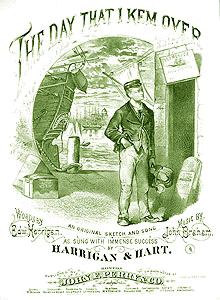
he portrays the more prosperous Irish sympathetically, but Harrigan's lyrics do sometimes criticize them for greed. Recent scholars of Harrigan's work such as Finson praise him for depicting the Irish more positively than had been done previously: "Harrigan was obviously an apologist for Irish Americans, and he portrays them . . . in the richest and most wide-ranging variety among all the urban ethnic groups" ("Realism" xxvii). Robert Toll notes Harrigan's Irish characters' work ethic and commitment to community: "His Irishmen were laughed at, but they were also hard workers; they engaged in political graft, but at the same time worked for their people" (177). Richard Moody agrees: "His Irish might be vagabonds and rogues, but never bums. Except at rare moments, his Irish didn't fight among themselves. He never drew on the battles that frequently erupted between Orangemen and Roman Catholics in New York" (113).
- Despite the very real tensions between the Irish, blacks, and Germans, Harrigan's plays emphasized humorous and general amiable relations between ethnic groups. As Moody merrily puts it:
Harrigan knew the sad side of tenement living, but he chose to write about holiday time, when the clouds lifted, games replaced work and worry, and Irish, Germans, and Negroes discovered a sunny and funny side to their animosities. Harrigan never dwelt on the heavy weather churned up by Irish and Negroes, such as the draft riots of 1863, when the Irish burned a Negro orphanage. His Germans, though stubborn, dumb, and heavy-footed, were not subjected to serious abuse. (113)
His reputation, therefore, is for presenting an egalitarian and communal picture of urban life. In an assessment of Harrigan and Hart's work published in The American Mercury in 1929, Isaac Goldberg wrote: "Essentially, the Mulligan cycle chronicles the racial antipathies that divided the Irish, the German and the Negro; but the antipathies are not so deeply rooted that they may not blossom into understanding and cooperation" (206).
- This reputation persists in contemporary critical studies. Alicia Koger described the frequent "melees" between the Irish and blacks as "loud and violent, yet good natured and fairmindedness usually restored peace. Above all, Harrigan wanted to depict harmony of the races who lived and worked closely together on the lower East side, so he always tempered the battles and insults with humor. Thus he made the racial problems seem less serious" (qtd. in Williams 170). Williams makes a similar argument:
Harrigan was among the first to recognize that within the crowded tenements of New York something like community could exist in spite of the poverty and ethnic tensions. Some of his best songs found something to celebrate in the rough urban culture coming into being around him. They recognize working-class Irish America as a community, which amid overcrowding and poverty, could take pride in its ability to survive and occasionally even prosper. (164)
I would agree that the plays attempt to create a new kind of community. But they signify community only to Irish Americans. The community does not include blacks in any egalitarian fashion. If blacks are part of the community, it must be made clear that the Irish run the community.
- The critical debate over Harrigan's black characters has focused on whether Harrigan's representations of blacks were positive or negative. For some time, Harrigan was praised for creating authentic black characters based on his own observations in New York and on stories he heard from his mother, who grew up in the south. For example, Moody reports that: "He studied the Negroes by talking with them, attending their balls and parties, observing the 'luxuriant side of their natures, their riotously funny simplicity' " (168). More recently, scholars have stressed that Harrigan's black characters have power. Williams notes their strength and resilience: "While Harrigan's stereotype of blacks is largely negative, they are at least allowed to be proud and disdainful of whites" (170). Finson argues that the depictions are no worse than those of the Irish and "For the most part, African-Americans in these songs seem to occupy a secure place in the urban landscape" (226). In several plays, Irish politicians must work hard to get the black vote, which leads Finson to conclude that "In Harrigan's world, African Americans were anything but disenfranchised" ("Realism" xxx). But even Howells, an admirer of Harrigan's, recognized problems with his black characters: "Not all the Irish are good Irish, but all the colored people [in the Mulligan series] are bad colored people. They are of the gloomy, razor-bearing variety; full of short-sighted lies and prompt dishonesties, amusing always, but truculent and tricky; and the sunny sweetness which we all know in negro character is not there" (316).
- However, the "power" of blacks signifies more than just a positive representation. Blacks are formidable competition for the Irish, and their political and economic power creates the tension between the groups that can flare up at any moment. Such powerful representations of blacks problematize Harrigan's reputation for realism. Dormon argues that Harrigan and Hart's work reflected prevailing stereotypes of the ethnic groups of their time more than "reality." He points out that their representations of blacks "were based in established caricature images . . . deemed typical, and again, wholly realistic, by the audiences of the day" (27). In addition, we must remember that the black characters in Harrigan's plays were white performers in blackface; "blackness" is performed by whites. Harrigan's work on the minstrel stage provided him with a deep well of images of blacks; minstrel songs, as Finson argues "threw fuel on the fire of an urban 'black scare'" (226-27).
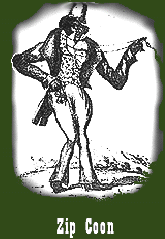
Dormon makes an especially salient point about how Harrigan used the Zip Coon figure, with his "dandy" clothing and razor, to represent the threat of blacks:
. . . in the Harrigan version, the blacks of lower Manhattan were not only comical in their pretensions, but also assertive, even aggressive, and in their proclivity for violence, potentially dangerous. . . . in no important way did the Harrigan caricature of American blacks differ from that of the stereotyped 'coons' of the 1890s, as they appeared in a seemingly endless succession of Tin Pan Alley hits. (29)
While The Mulligan Guard Ball is not minstrelsy per se, it draws on the minstrel tradition simultaneous anxiety about and fascination with blacks. [A good web resource for minstrelsy is: http://calvin.nebrwesleyan.edu/wcb/schools/2/21/swarfiel/11/modules/page6.html]
- Lott and Roediger have argued that blackface served as a method of establishing white identity. Roediger asserts that "blackface minstrels were the first self-consciously white entertainers in the world. The simply physical disguise--and elaborate cultural disguise--of blacking up served to emphasize that those on stage were really white and that whiteness really mattered" (117). I read Harrigan's work as part of this establishment of whiteness because it creates clear distinctions between blacks and Irish in spite of their similarities. Harrigan's "types" constructed the Irish as a more tame group than blacks; the Irish may not be model citizens, but they don't wield razors. However, the play also makes that hierarchy tenuous and comical by continually revealing their shared characteristics. I contend that the humor, song and boisterous action in Harrigan's plays does not resolve all the conflict between Irish and blacks; it remains in tension with a very real threat of violence.

- In 1889, Harrigan wrote "If I have given undue prominence to the Irish and the negro, it is because they form about the most salient features of Gotham humanity, and they are the two races who care the most for song and dance" ("American Playwrights on American Drama" 97). The Mulligan Guard series best displays Harrigan's interest in the interaction between blacks and the Irish.
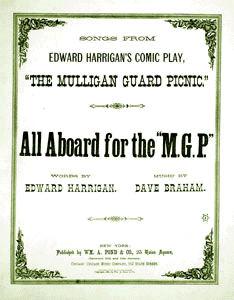
The series began as a sketch and a song in 1872 and became a full-length play, The Mulligan Guard Picnic in 1878. The next play, The Mulligan Guard Ball, was a huge hit for Harrigan and Hart in 1879. [5] It satirized the shooting and pseudo military clubs that had become popular in New York at mid-century. [6] The clubs were organized by ethnic groups that were excluded from the city's official militia. According to Moody, the Guards' drills were highly individualized and became quite raucous celebrations:
Usually they assembled at the neighborhood engine house, squirmed into formation, marched to the home of the leading politician for his blessing, and then headed uptown to Jones's Woods or to Harlem, or down to the Battery for a boat to Staten Island or Hoboken Heights. A drum and fife corps, hired or improvised from their ranks, kept them in step . . .Their homemade uniforms rarely matched. . . . Ingenuity, pawnbrokers, and secondhand shops supplied medals, boots, bearskin shakos, leather aprons, and leggins. . . . The companies' morning manuvers, even before the disrupting influence of beer, were as individualized as their costumes" (47-48)
The theatrical quality of the Guards made them perfect for Harrigan's style of theater. The target companies led to some boisterous stage play, "knockdown and slapbang," characteristic of all of Harrigan's work. They become so successful that Harrigan wrote a series of Mulligan Guard plays: The Mulligan Guard Picnic (1878); The Mulligan Guards' Christmas (1879); The Mulligan Guard Chowder (1879); The Mulligan Guard Nominee (1880); The Mulligan Guards' Surprise (1880); and The Mulligans' Silver Wedding (1881). All of the plays feature Dan Mulligan, the Captain of the Skidmores, and his wife Cordelia.
- The series also features the black Skidmore Guard as a foil/double to the Mulligans. Harrigan depicts black and Irish characters as similar in their singing and dancing talents, their shared work, and their leisure activities, such as drilling with the Guards. However, black characters are not presented with the same range of emotion or experiences as Irish characters. Harrigan is most interested in the identity and the place of his Irish characters; we don't find anything about the family life of the African Americans, for example. They have only public, group lives. This is even reflected in the types of songs they sing, which were, as Williams points out, "usually group pieces, marches, and psuedo-spirituals, typical of the 'plantation' or 'camp meeting' choruses that whites accepted as genuine African American music" (272).
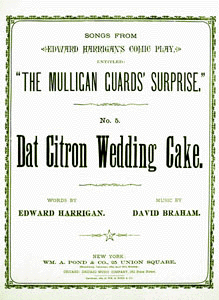
The play takes place in the Mulligan home where the Lochmullers also live as tenants, Simpson Primrose's Barber Shop, the Wee Drop Saloon, and the Harp and Shamrock Hall.
- The plot of The Mulligan Guard Ball centers on two conflicts which are rooted in ethnic tension. Tommy Mulligan, Dan and Cordelia's son, wants to marry Kitty Lochmuller; Dan opposes the marriage because Kitty's father, the butcher, is German. Secondly, a confrontation erupts over the mistaken "double booking" of the Mulligan Guard and Skidmore Guard balls on the same night in the same hall. (This mistaken double booking is characteristic of the Mulligan plays, and it usually brings about a "melee"). [7] Dan Mulligan's prejudice against Germans is established in his response to Tommy's courtship of Kitty: "Tommy, understand, em. The name of Mulligan will never be varnished wid the name of Lochmuller. The divil of a drop of Dutch blood will ever enter the family and I want you to understand, that goes" (15). But such prejudice is not held only by the Irish. Clear hierarchies are observed between all the ethnic groups; while Dan Mulligan feels that he is superior to the Germans, both he and Lochmuller consider themselves better than the Italians. Lochmuller says about his wares: "Them is second hand bolognas. I sell dem to Italians" (18). Lochmuller also expresses resentment towards the Irish. Economic equality that undermines some of Dan's superiority, though; although Lochmuller rents from Mulligan, Mulligan owes him fifteen dollars on his butcher's bill.
- The two black characters are Simpson Primrose, "a dandy barber" (23) who resembles the "Zip Coon" character, and his friend and sidekick, Palestine Puter, the chaplain of the Skidmores. They refer to the Irish as a nuisance at best, a threat at worst. In his barber shop, Primrose makes a joke about Irish drinking:

"You'll find alcohol dar for rubbing purposes. De last Irishman took a bath dar drank it" (36). They are exasperated by the Irish presence in New York. Puter reports that: "De ancient Order of Full Moons is a secret colored society to prevent de Irish from riding on horse cars" (25). Puter talks about the Irish as an invading force: "I don't see why de government can't quarantine dem people, dey land too sudden. Dar ain't enough fumigation" (26). After an argument over money with Honora Dublin, an Irish woman who washes the towels for the barbershop, Primrose says: "Dat's de last wash you'll ever get from me. I was opposed to de Chinamen ever coming to dis country, but hereafter of de two European elements Milesian and Mongolian, give me de Mongolian" (42). [8] Primrose and Puter see themselves as the real Americans and the Irish as the outsiders. Throughout most of the first act, such lines are humorous, but occasionally something darker comes through. When Puter expresses concern about holding the Skidmore Guard Ball at the Irish hall, he says, "The committee am forced to another hall called de Harp and Shamrock. (Aloud) Dat's an Irish hall, dare aint a Full moon can go in dat hall widout trouble" (26).
- In the public spaces of the barbershop, the Harp and Shamrock, and the street, such interactions are on equal footing. In the barbershop, we see the political and economic power that Dan Mulligan represents. Primrose comments about Tommy that "His father's a power in dis ward" (31) and Dan makes it clear that he brings in business: "Shave me first if you don't the divil a one of the Mulligans will ever lather in here again" (51).
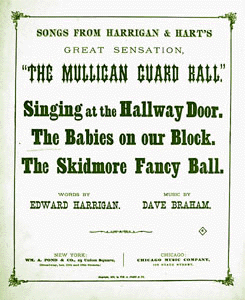
But the Skidmores also have status; for example, a newspaper reporter plans to write about the Skidmore ball before he knows about the Mulligan ball. Several customers insult Primrose about the cleanliness of his shop, and whether or not he's charged them fairly for his services. The groups can trade insults freely because each depends financially on the other. But the seemingly harmless bickering reveals a black threat underneath; when Lochmuller says that perhaps a German could "beat a nigger," Simpson says "Hold on, you see dis razor? . . . . I'm Simpson Primrose, Captain of de Skidmore. Every man of dem is N.G.-- Nice Gentlemen. Now you'll apologize or I'll draw dis razor cross your jugular" (55-6). Interestingly, Dan comes to Primrose's defense (partly), by acknowledging: "A man has no right to insult a colored man to his face" (56). No other group's violence or anger erupts to this degree. So before the conflict over the hall, blacks are established as the most violent of the ethnic groups.
- As the Skidmore Guard prepares to go to the Harp and Shamrock for the ball,

Simpson warns them to arm themselves for possible trouble with the Irish. Despite his joking early in the day, Simpson does not order his men to attack the Mulligans. He speaks in terms of both self defense and a sort of pride and determination that the Skidmores be allowed to hold their ball as planned:
Members I ordered you to carry arms tonight at de Skidmore Fancy Ball. Kase we were forced to give up Lyric Hall and take de Harp and Shamrock. Dars no telling how many Irish will be in ambush dar so on going in de hall you can put your muskets in de hat rack and every man have his razor ready. No one must interfere with our pleasure. (91)
Again, Puter reveals his general disdain for the Irish and his willingness to get in a fight with them: "I'm again de shedding of blood but when it comes to dem people you all know me" (91).
- The conflict over the Harp and Shamrock hall brings the black-Irish hostility and doubling to their peak. Their songs at the balls emphasize their similarities; both groups celebrate their own ranks. In the "Skidmore Fancy Ball" the Skidmores boast about their strength and the quality of their dancing:
Oh, here we go so nobly oh! de Colored Belvedere
A number one, we carry a gun, we beat the Fusileers
You talk about your dancers when we hear the cornet call
We wing and wing, de dust we sling, at de Skidmore Fancy Ball
Now right and lef, just hold your bref
We're bonton darkies all
De fat and lean get in and scream at the Skidmore Fancy Ball[.]
In "The Mulligan Guard" the Irish celebrate their marching style:
Our Captain's name was Hussey, A Tipperary man
He carried his sword like a russian duke when ever he took command
We shoulder'd guns, And March'd and march'd away
From Baxter street we marched to Avenue A
With Drums and Fife, how sweetly they did play
As we March'd march'd march'd in the Mulligan Guard[.]
The song also plays up the Irish penchant for drink:
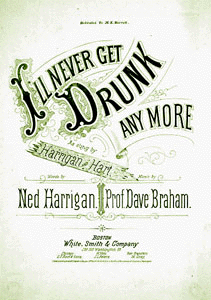
When we got home at night boys,
The divel a bit we'd ate
We'd all set up and drink a sup,
Of whiskey strong and nate.
Thin we'd all march home together,
As slippery as lard,
The solid min would all fall in
And march in the Mulligan Guards[.]
- When the Skidmores arrive at the Harp and Shamrock and discover that the Mulligans are already there, the Mulligans begin insulting them immediately. Dan asks them "What do you coons want here?" and calls them "ink bottles" (96). During the dispute, Tommy and Kitty run off to be married, which brings the Germans into Dan's family life while he fights off the Skidmores. The Skidmores do not engage in verbal insults; they instead show their razors. Things get tense quickly; Simpson asks "What are you Irish tresspassing here for" [sic] (97). He tells his men "Look to your arms gemman" and the stage directions read "Bus. of razors with guards who drew razors" (97). The Irish crowd are yelling to "Kill the niggers" while the "Negroes keeping Irish off with razors" (97). The situation boils up to a physical confrontation and then talk of some kind of compromise cools things down; the guards are barely kept apart each time. No jokes are told during this scene; Moody suggests that the performance suggested serious violence: "The free-swinging combat was not improvised on the spur of the moment not was it as mild as the stage directions seem to suggest. Harrigan provided meticulous choreography at the rehearsals" (89).
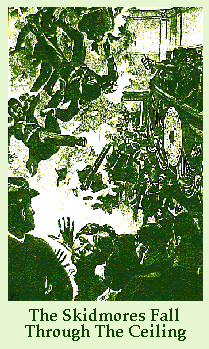 After they work out an agreement for the Skidmores to use the hall on the floor above the Mulligans for a reduced rate, Simpson says, "as long as we're up stairs, we're above the Irish. And I know dat suits every full moon in de company" (99). The guards cheer each other after the agreement is made, and the razors are put away.
After they work out an agreement for the Skidmores to use the hall on the floor above the Mulligans for a reduced rate, Simpson says, "as long as we're up stairs, we're above the Irish. And I know dat suits every full moon in de company" (99). The guards cheer each other after the agreement is made, and the razors are put away.
- But soon after peace is restored, while both groups dance and sing, the floor above the main floor breaks and the Skidmores fall through the ceiling, losing their place over the Mulligans. The stage directions read: "Chandelier falls on Dan. Negro dummies wenches and soldiers fall through ceiling. Simpson Puter and four negroes enter at back. A Melee and Curtain" (102). It is a funny and chilling image: blacks have risen "above" the Irish, but their dancing and singing--the very qualities they share with the Irish--brings them crashing down. They are forced to be together despite their desire to be apart. Here the staging makes the tension and violence humorous. Moody describes the scene: "The pileup of arms and legs, smothered in plaster and entwined with the chandelier, created an astonishing spectacle--and a dreaded nightmare for the stage mechanics" (87). No one is cut or slashed in the third act, so the melee does not seem to have brought out the razors. But it has brought the Skidmores "down." The melee defuses the threat of real violence by exaggerating it, pushing at its limits.
- In the final act, calm has been restored, as if the tension built up previously has been broken,
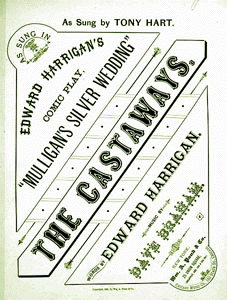
contained by the merry melee which leaves the Irish on top. It is Dan and Cordelia Mulligan's Silver Wedding Anniversary. It begins in the Mulligan home, as the first act did, where Dan's place is secure. There are a few brief comments about the melee the night before; Cordelia complains that she has "a black spot on my shoulder where a nagur fell on me from the ceiling" (106) and Lochmuller remarks that "De Skidmore Guards were carried out on stretchers" (106). Moody reports that Primrose appeared on stage with a white eye, indicating that he'd been punched (90). Cordelia bickers with Lochmuller about the rent; she says "We own the house and we have the floor above you" to which he responds "Yes and sometimes, like the niggers, you fall through the ceiling" (108)--a funny line, but also a barb at the possibility that the Mulligans' status is not so secure.
- Simpson and Puter make a visit to the Mulligans to retrieve a shirt and a badge that they lost in the melee; their visit confirms that they have been put in their place. The danger they felt encountering the Irish in act one is replaced with jokes and malapropisms:
Simpson: We're on a dangerous mission.
Puter: Yes and I'm a dangerous missionary.
Simpson: Secretion is the better part of valor.
Puter: Dat's wisdom wasted on the Irish. (112-113)
Completing the "victory" over the Skidmores, Cordelia asks Puter and Primrose to work the anniversary party that night as waiters, a job that contains their previous threat in the roles of workers for the family party. But the play offers one more sly "fall through the ceiling"; Simpson informs Dan that he's been wearing Simpson's shirt, and it even has a full moon on it. The play ends with Harrigan and Braham's "Our Front Stoop," a song of Irish community:
I'm the father of a fami-ly, six girls and one big boy
With the neighbors they are friendly, they are their mother's joy
It's every summer's evening when the heat would make you droop
Old friends would meet from every street to talk on our front stoop
There is dainty Missus Grogan, and Alex McAfee
With the undertaker Hogan, the pride of Calvary
Oh! you should hear the warblers they'd burst an opera troup
"Sweet by and by" would make one die as sung on our front stoop[.]
Harmony and humor prevail again for Harrigan and Hart, but just barely.
- In some later Irish-American literature, like James Farrell's Studs Lonigan trilogy (Young Lonigan -1932; The Young Manhood of Studs Lonigan-1934; Judgment Day-1935) or Jimmy Breslin's World Without End, Amen (1973), only hostilities exist between blacks and Irish. In Irish literature which imagines a black-Irish relationship, like Roddy Doyle's The Commitments (1987), there seems to be too much romantic gloss. I suggest that Harrigan's work is essential to our understanding of black-Irish relations, because it reveals the complexities and constant slippage between identification and anger. In the Mulligan guard melees, it is often impossible to tell who is on top. That confusion may the best way to complicate our understanding of race and the diaspora.
Notes
- Ignatiev's book has been criticized on this very point. Eileen McMahon asserts that:
This Marxist thinking places a moral burden on poor, mostly illiterate (in the antebellum period) immigrant Irish that I think is unfair, as is the assumption that the Irish had it within their power to save American society from racial division. . . . While one might wish that the Irish had shown greater racial tolerance and bridged the racial divide in America, to expect a people who had been so impoverished and humiliated at the hands of the English and who came, some diseased and starving, from a pre-capitalist, primitive agricultural society, to have tried to do anything but survive as best they could in a strange and sometimes hostile society is expecting a great deal. (571)
Even reviewers who agree with Ignatiev's basic thesis about Irish agency, such as Diane Negra, see his argument as too simplistic:
Ignatiev evaluates the whitening of Irish-Americans from an exclusively Irish perspective that appropriately emphasizes their agency in the process, but also leaves out other elements within broader American culture which certainly would have helped the Irish qualify for the status and privilege of whiteness. In other words, it seems unlikely that the Irish were whitened simply and exclusively as a function of Irish self-determination. (112) Back
- For disucssions about the representation of history in The Irish in America, see Eagan, Fanning, and Richardson. Back
- In general, see Allen. Back
- The Irish role in minstrelsy is especially revealing of both hostility and identification between Irish Americans and African Americans (see Lott's Love and Theft.)Back
- Moody reports that the play was performed 153 times: "In recent years, when the Broadway theatre has been dominated by long runs and when a play can not claim success until after 100 performances, The Ball's record appears less spectacular. In 1879, it was an astonishing feat. Theatres like the Comique and Tony Pastor's invariably introduced new programs each Monday night; legitimate theatres might sometimes run a play for six to eight weeks; only occasional oddities like Uncle Tom's Cabin and The Black Crook held the stage for long runs" (87). Back
- All reports are that Harrigan saw the target companies as a nuisance, hence the satire of their drinking and fighting. Back
- In The Mulligan Guards' Christmas, for example, both guards choose the same location for target practice. Back
- "Milesian" is a reference to the Spanish king whose sons are reputed to have conquered and reorganized the ancient kingdom of Ireland about 1300 BCE. Back













 After they work out an agreement for the Skidmores to use the hall on the floor above the Mulligans for a reduced rate, Simpson says, "as long as we're up stairs, we're above the Irish. And I know dat suits every full moon in de company" (99). The guards cheer each other after the agreement is made, and the razors are put away.
After they work out an agreement for the Skidmores to use the hall on the floor above the Mulligans for a reduced rate, Simpson says, "as long as we're up stairs, we're above the Irish. And I know dat suits every full moon in de company" (99). The guards cheer each other after the agreement is made, and the razors are put away. 